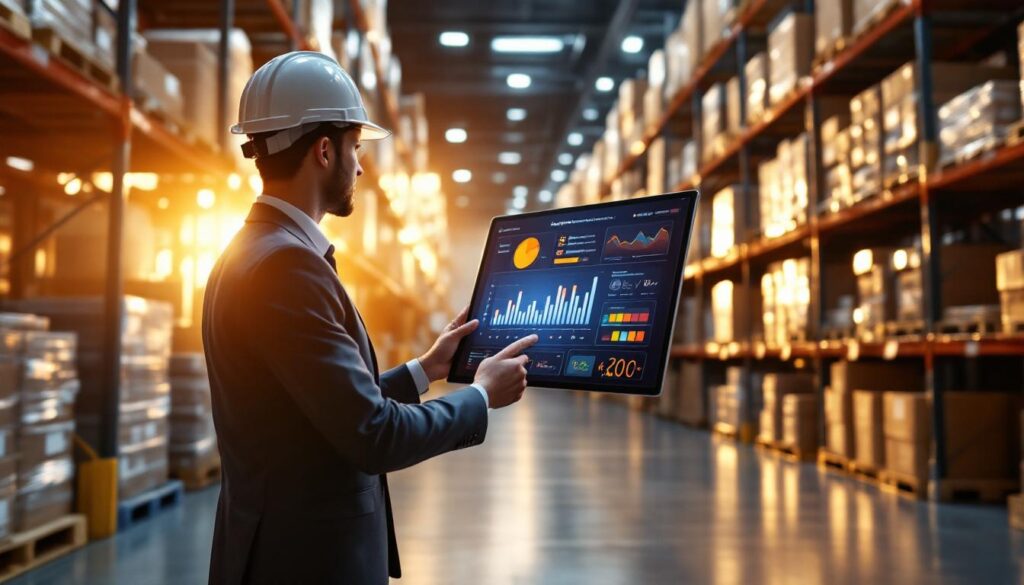Trade tariffs add layers of complexity to global supply chains, slowing down operations and raising costs for many businesses. When shipments cross borders, the rules and fees can change quickly, making compliance a real headache. Companies need a way to stay organized and avoid costly mistakes.
Leanafy WMS helps businesses handle trade tariffs with less stress. It keeps all the key compliance details in one place, tracks changing rates and helps teams avoid fines or shipping delays. With the right tools, your team can ship products worldwide with confidence, improve accuracy and focus on growing your business.
Understanding Trade Tariffs and Their Supply Chain Impact

Trade tariffs are taxes set by governments on goods that move across borders. They affect almost every business that deals with suppliers or customers from other countries. These fees change how products are priced, handled and shipped worldwide. If you manage a warehouse or organize shipments, you know how these changing rules can create real problems that slow things down and eat into profits.
Trade tariffs go beyond paperwork. They shape supply chains in ways that require careful attention and quick adjustments. Let’s break down what you need to know.
What Are Trade Tariffs?
A trade tariff adds a required fee to goods when they move from one country to another. This could be a set dollar amount per item or a percentage of the product’s total value. Governments add tariffs to protect local businesses, manage trade balances, or respond to international disputes.
Here’s how tariffs can affect your business:
- Higher Costs: Every product entering a country may cost more, which hits your margins.
- Pricing Decisions: You might have to rethink your pricing or look at new suppliers.
- Unpredictable Rules: Tariffs can change quickly, creating confusion for importers and exporters.
How Tariffs Affect Businesses
Trade tariffs reach deep into a company’s daily routine. Even small changes make a big difference when you handle thousands of items or serve multiple countries. Companies often need to:
- Track tariff changes for every product and supplier.
- Adjust inventory buying strategies on short notice.
- Respond to customs holds or surprise charges.
Every extra step adds work for your operations team and risk for your bottom line. Any mistake can mean costly delays or fines, adding more headaches to the process.
Supply Chain and Warehouse Management Challenges
Warehouses don’t just store goods; they help keep everything moving smoothly from the supplier to your customer. Trade tariffs put pressure on this process in several ways:
- Inventory Planning: Sudden cost changes force you to rethink how much to stock and where to keep products.
- Documentation: Accurate records are critical. Missing or incorrect paperwork can stop shipments in their tracks.
- System Updates: Your warehouse management system (WMS) must handle changing codes, rates and rules as they happen.
A strong WMS helps avoid these pain points. It keeps records clear, tracks tariff changes and offers real-time insights into your stock and costs. For example, using solutions that focus on supply chain optimization like Warehouse Management Solutions can streamline operations, minimize errors, and support compliance.
Understanding how trade tariffs work (and how quickly they change) helps your team respond with speed and confidence. The right knowledge and systems can mean the difference between steady shipments and costly delays.
Key Features of Leanafy WMS for Navigating Trade Tariffs
Leanafy WMS stands out for its advanced tools that take the pain out of trade tariffs. This system brings together automation, data accuracy, and up-to-the-minute information, making it much easier to stay compliant and avoid costly errors during import or export. Here’s how its specialized features support you every step of the way:
Automated Documentation and Customs Support
Managing paperwork for trade tariffs is often slow and full of risk. Leanafy WMS replaces manual tasks with smart automation, keeping documents digital, clear, and always ready for inspection.
- Digital Recordkeeping: Every shipment comes with electronic logs, invoices, bills of lading, and certificates, so nothing gets lost in the shuffle. The system attaches these documents directly to inventory records, making audits faster and smoother.
- Automated Customs Forms: Customs paperwork and tariff declarations are auto-filled based on your shipment details, cutting down on errors and saving time. This reduces the chance of incorrect data that might lead to delays or fines.
- Audit Trails for Tariff Compliance: Leanafy WMS tracks every change, user action, and approval along the way. Auditors can see what was done and when, simplifying compliance with both local and international regulations.
Shipping goods across borders doesn’t have to mean stacks of paperwork or last-minute scrambles. Leanafy’s automated tools let teams focus on moving goods instead of chasing signatures.
Advanced Inventory Tracking for Accurate Tariff Calculations
Trade tariffs hinge on precise product classification and value. Leanafy WMS raises the bar with clear, detailed inventory monitoring.
- Granular Visibility: Each SKU in your warehouse has a full profile, including its country of origin, harmonized codes, material makeup, and declared value. This ensures tariffs get calculated using the right data every time.
- Prevents Classification Errors: With up-to-date product databases, Leanafy WMS helps avoid costly misclassification, which is one of the top reasons for customs delays and higher duty charges.
- Valuation Support: Track each item’s purchase price, market value, and declared trade invoices in real time. The system flags discrepancies and helps teams make corrections before shipments reach customs.
Teams using this WMS have better control over tariff calculations and fewer surprises at the border. For a deeper dive into these systems as a whole, check out Understanding Warehouse Management Systems.
Integration with Tariff Databases and Real-Time Updates
Tariff rates and trade agreements can change with little warning. Leanafy WMS keeps you updated by connecting directly to trusted industry and government sources.
- Direct Sync with Tariff Databases: The platform links to databases for current tariff rates, country codes, and import/export restrictions, so your calculations are always up-to-date.
- Real-Time Notifications: Get alerts if rules, rates, or required paperwork change for your products, so your team can adjust shipping or pricing on the fly.
- Supports Complex Trade Agreements: Whether you’re dealing with NAFTA, EU regulations, or other regional deals, Leanafy WMS updates classifications and rate tables automatically.
These integrations are part of a broader push for smoother operations. To see how linking warehouse systems with outside databases transforms efficiency, read about WMS integration types.
Staying on top of trade tariffs is easier when your tools update themselves. This level of automation helps you avoid surprises and keep shipments flowing.
Optimizing Workflow to Minimize Tariff Costs
Cutting trade tariff costs isn’t just about knowing the latest rates—it’s about structuring your warehouse workflow to limit exposure before shipments even leave the dock. By combining efficient picking strategies and running smart scenario simulations, Leanafy WMS places control directly in your hands. The right process doesn’t just improve speed, it keeps your fees low and avoids surprise expenses.
Wave Picking and Smart Order Consolidation
Tariff costs often depend on shipment size, origin, and the specific mix of goods in a container. If you process orders one-by-one, you might pay the highest duty rate on every shipment. But what if you could group products and ship smarter? Leanafy WMS uses wave picking and consolidation tools to transform how orders move through your warehouse.
Here’s how grouping and consolidation with Leanafy WMS can help:
- Group by Tariff Bracket: Orders heading to the same destination or with similar classification codes can be combined to hit more favorable tariff brackets, sometimes bringing the average cost per unit down.
- Fewer Shipments, Lower Fees: By consolidating orders, you reduce the number of shipments, which often means fewer processing fees and simpler paperwork.
- Optimize Load Mix: The system recommends the best way to mix SKUs to minimize the highest duty rates within a single container.
- Reduce Partial Shipments: Sending out half-filled containers only raises costs. With wave picking, you make full use of every shipment, keeping tariff-related fees low.
Curious about how this works behind the scenes? Leanafy WMS uses powerful algorithms to sort, group, and release picks in “waves” that match your efficiency and tariff goals. For a closer look, Wave Picking WMS Solutions explains why wave picking is changing the way warehouses operate.
Smart consolidation isn’t just a warehouse win, it’s a cost control strategy. If you want to stay agile in an ever-changing tariff landscape, efficient wave picking is key.
Scenario Analysis for Duty Optimization
What if you could preview the tariff cost impact of every sourcing or shipping decision before you actually move inventory? Scenario analysis turns uncertainty into clarity.
Leanafy WMS brings scenario simulation into your daily workflow. The system lets you model different shipping and sourcing options, showing side-by-side how each impacts trade tariff costs. Here’s why that matters for cutting expenses:
- Test Alternate Routes: Evaluate if shipping from one country over another changes your total landed cost due to different tariff rates or trade agreements.
- Supplier Comparison: Quickly see how changing suppliers affects duties, especially if you’re balancing between domestic and international options.
- Inventory Origination Planning: Know in advance what happens to tariff costs if products are shipped from a different regional warehouse or country of origin.
- Bulk vs. Split Shipments: Model the duty impact of sending one large shipment versus several smaller ones—sometimes bulk is best, but not always.
- Instant Cost Forecasts: The WMS provides quick cost summaries for every scenario, empowering your team to negotiate or adjust before making big decisions.
By using dynamic simulations, your team can plan a few moves ahead, not just react to new rules. This boosts confidence—and bottom-line results—across every shipment. It’s a proactive way to keep tariff headaches at bay without slowing down your supply chain.
Getting the logistics right means keeping every dollar possible in your pocket, rather than paying it out as unnecessary fees. With these strategies built into your warehouse management system, smart workflow isn’t just a hope, it’s your daily reality.
Best Practices for Ongoing Tariff Compliance with Leanafy WMS
Staying compliant with trade tariffs isn’t a one-time job. Rules change, rates shift, and even a small slip can mean big fines or delays. A warehouse management system like Leanafy WMS works best when everyone in your operation knows the playbook, audits are regular, and your processes stay fresh and up-to-date. Let’s lay out some practical steps you can use to keep your team sharp and your shipments moving without headaches.
Training Teams for Compliance Confidence
Keeping your team up to speed on trade tariffs is step one. Leanafy WMS makes this easier by centralizing resources and creating simple, trackable workflows. But technology isn’t enough—team education must become part of your routine.
Key strategies for training success:
- Onboard with Hands-On Learning: New hires start strong when you walk them through the tariff compliance features in Leanafy WMS. Set aside time for demo sessions with real examples.
- Regular Refresher Sessions: Run short workshops or lunch-and-learns that highlight recent tariff changes, system updates, or common mistakes. It helps everyone stay alert and confident.
- Job Aids and Checklists: Create easy-reference guides for tasks like documentation, customs reporting, or tariff code lookups. Products change, but the basics don’t—make sure these materials get regular updates.
- Cross-Training: Rotate team members through related jobs so more people understand the end-to-end process. This keeps things running smoothly even if someone is out.
Consistent, clear communication matters most. When everyone “speaks the same language” about compliance, you spot issues faster and correct them with less fuss.
Auditing Processes for Ongoing Accuracy
Even the best teams miss things sometimes. Regular process audits help you find and fix gaps before they turn into problems. Leanafy WMS has built-in reporting, making this less of a burden and more of a routine checkup on your warehouse’s health.
How do you audit well?
- Set a Regular Schedule: Choose a cycle that fits your shipping volume, like monthly or quarterly. Stick to it.
- Random Spot Checks: Don’t just check the same files every time. Pull random shipments, compare paper trails to WMS records, and look for red flags.
- Analyze Error Patterns: Use WMS reports to spot repeated mistakes—maybe a certain product line or vendor causes more issues.
- Keep a Continuous Improvement Log: Record what’s caught in each audit, what got fixed, and any training that followed. Over time, this creates a knowledge bank that your whole team can use.
Regular auditing builds a culture of care. It shows your team that accuracy matters every day, not just during big reviews.
Staying Ahead of Changes in the Trade Tariff Environment
Trade tariffs aren’t static. Governments make changes quickly, and those changes ripple through supply chains almost overnight. Your WMS should be your early-warning system, but your business processes must stay nimble too.
Tactics to keep you ready:
- Monitor Regulatory Feeds: Leanafy WMS connects to external tariff databases and government notices, so enable these alerts for key roles in your team.
- Designate a Compliance Champion: Appoint a team member to watch for rule changes, update internal documents, and train others on what’s new.
- Scenario Planning: If you see talk of new tariffs or rules, use the system’s scenario tools to predict cost or routing impacts before changes land. React fast, not last.
For teams that want a deeper understanding of how WMS automation can help respond to regulatory changes and support compliance, What Is a WMS and Why Do You Need One? is a helpful place to start.
Change is constant, but with the right tools and habits in place, your business can adapt at full speed. Regular reviews, smart training, and up-to-date systems are your best defense against surprises in the tariff world.
Conclusion
Using Leanafy WMS can turn the constant challenge of trade tariffs into a real chance to fine-tune your supply chain. The strength of this system lies in its ability to automate compliance, track changes in real time, and help you control costs at every step. By leaning on an integrated, automated approach, you protect your business from costly errors and keep your global shipments on track.
Trade tariffs don’t have to slow you down or cut into your profits. A clear process and the right warehouse management system let you meet new requirements without missing a beat. Interested in how the best systems stack up? Check out insights on Top WMS Systems 2025 to keep your operations strong and your compliance effortless.
Thank you for reading. Does your team have a process for handling tariff changes, or are you ready to upgrade your strategy? Let us know how you’re turning global trade challenges into wins.



